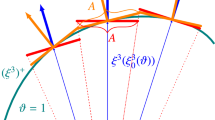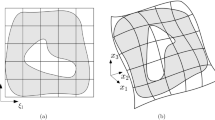Abstract
In the present paper, the finite deformations of a laminated inhomogeneous spherical shell are studied. A laminated shell can be considered as a limit case for multilayered shells when the thickness of each layer tends to zero while their quantity tends to infinity. Such a limit might be useful in modeling of multilayered structures with large amount of layers, for example, produced by layer-by-layer additive manufacturing. It is easy to explain the nature of inhomogeneity for multilayered structures (discrete inhomogeneity). It is just the result of the fact that in the stress-free state the shapes of layers do not fit to each other. Thus, they cannot be assembled without gaps or overlaps. Proper assembly becomes possible only after individual deformations of layers that cause self-equilibrated stresses in their assembly. The explanation of inhomogeneity for laminated structures (continuous inhomogeneity) is slightly more complicated. It can be given upon the idea of a continuous family of reference shapes that are free from stresses only locally. In the present paper, this approach is discussed in detail. To define measures for stresses and strains on laminated structures, one has to determine corresponding fields in some specific way. Such definitions that are obtained by formalism, adopted in the theory of smooth manifolds with non-Euclidean connection, are also given. To compare a discrete inhomogeneity with its continuous counterpart, the stress–strain states for the sequence of multilayered structures have been examined. The common factor of these structures is that they have equal final volume. Meanwhile, the number of layers increases with their order in the sequence. The measure for inhomogeneity related with non-Euclidean connection is found from a nonlinear evolutionary problem. To support improved understanding of the interplay between multilayered and laminated structures, the stresses and strains exerted in them are studied in comparison. Considerations of the reverse situation, in which some multilayered structure with discrete inhomogeneity is defined upon a given laminated structure, are also carried out. The convergence with decreasing maximal thickness for layers to the original laminated structure is illustrated numerically. In this, one can see similarity with the partitioning procedure in the theory of integrals.
Similar content being viewed by others
Abbreviations
- \(\mathcal {P}\) :
-
Physical space
- \(\mathcal {E}\) :
-
Three-dimensional Euclidean affine space
- \(\mathcal {V}\) :
-
Translation vector space, associated with \(\mathcal {E}\)
- \(\mathfrak {B}\) :
-
Body
- \(\vee \) :
-
Joining operation
- \(\varvec{g}\) :
-
Riemannian metric on \(\mathcal {P}\)
- \(\varvec{G}\) :
-
Riemannian metric on \(\mathfrak {B}\)
- \(\mathfrak {M}\), \(\mathfrak {N}\) :
-
Smooth manifolds
- \(\mathrm{Diff}(\mathfrak {M})\) :
-
The set of all diffeomorphisms on smooth manifold \(\mathfrak {M}\)
- \(C^{\infty }(\mathfrak {M};\,\mathfrak {N})\) :
-
The set of all smooth mappings between smooth manifolds \(\mathfrak {M}\) and \(\mathfrak {N}\)
- \(\mathrm{Em}(\mathfrak {M};\,\mathfrak {N})\) :
-
The set of all smooth embeddings between smooth manifolds \(\mathfrak {M}\) and \(\mathfrak {N}\)
- \(T\mathfrak {M}\) :
-
Tangent bundle of smooth manifold \(\mathfrak {M}\)
- \(T^{*}\mathfrak {M}\) :
-
Cotangent bundle of smooth manifold \(\mathfrak {M}\)
- \(\mathrm{Sec}(\mathfrak {E})\) :
-
Vector space of smooth sections of a vector bundle \(\mathfrak {E}\rightarrow \mathfrak {M}\)
- \(\varkappa \) :
-
Configuration
- \(\gamma \) :
-
Deformation
- \(\varvec{I}\) :
-
Identity tensor
- \(\varvec{F}\) :
-
Deformation gradient
- \(\varvec{K}_{\mathfrak {X}}\) :
-
Local configuration at point \(\mathfrak {X}\)
- \(\varvec{T}\) :
-
Cauchy stress tensor
- \(\varvec{P}\) :
-
First Piola–Kirchhoff stress tensor
- \(a_{n,\,k}\) :
-
Parameter of the deformation of kth layer in nth assembly
- \(\alpha \) :
-
Evolution parameter
- \(b_{\alpha }\) :
-
Local distortion that corresponds to the value \(\alpha \) of the evolution parameter
References
Abraham, R., Marsden, J.E., Ratiu, T.: Manifolds, Tensor Analysis, and Applications, vol. 75. Springer, New York (2012)
Adachi, M.: Embeddings and Immersions. American Mathematical Society, Providence (2012)
Bilby, B., Bullough, R., Smith, E.: Continuous distributions of dislocations: a new application of the methods of non-Riemannian geometry. In: Proceedings of the Royal Society of London A: Mathematical, Physical and Engineering Sciences, vol. 231, pp. 263–273. The Royal Society (1955)
Campbell, T., Williams, C., Ivanova, O., Garrett, B.: Could 3D Printing Change the World? Technologies, Potential, and Implications of Additive Manufacturing. Atlantic Council, Washington (2011)
Dautray, R., Lions, J.L.: Mathematical Analysis and Numerical Methods for Science and Technology. Volume 5 Evolution Problems I. Springer, New York (2000). https://doi.org/10.1007/978-3-642-58090-1
de Wit, R.: Fundamental aspects of dislocation theory, vol. I, chapter Linear Theory of Static Disclinations, pp. 651–673. National Bureau of Standards (U.S.) (19 70)
Decher, G., Schlenoff, J.B. (eds.): Multilayer Thin Films. Wiley VCH Verlag GmbH, London (2012)
Edelen, D.G.: A four-dimensional formulation of defect dynamics and some of its consequences. Int. J. Eng. Sci. 18(9), 1095–1116 (1980). https://doi.org/10.1016/0020-7225(80)90112-3
Eliseev, V.: Mechanics of Elastic Bodies. Saint Petersburg State Polytechnic Publishing House, Saint Petersburg (2003). (in Russian)
Epstein, M.: The Geometrical Language of Continuum Mechanics. Cambridge University Press, Cambridge (2010)
Epstein, M., Elzanowski, M.: Material Inhomogeneities and Their Evolution: A Geometric Approach. Springer, New York (2007)
Gibson, I., Rosen, D.W., Stucker, B., et al.: Additive Manufacturing Technologies. Springer, New York (2010)
Goloveshkina, E.V., Zubov, L.M.: Universal spherically symmetric solution of nonlinear dislocation theory for incompressible isotropic elastic medium. Arch. Appl. Mech. (2018). https://doi.org/10.1007/s00419-018-1403-9
Gurtin, M.E., Murdoch, A.I.: A continuum theory of elastic material surfaces. Arch. Ration. Mech. Anal. 57(4), 291–323 (1975)
Hodge, N., Ferencz, R., Vignes, R.: Experimental comparison of residual stresses for a thermomechanical model for the simulation of selective laser melting. Addit. Manuf. 12, 159–168 (2016). https://doi.org/10.1016/j.addma.2016.05.011. (Special Issue on Modeling & Simulation for Additive Manufacturing)
Husemoller, D.: Fibre Bundles. Springer, New York (1994). https://doi.org/10.1007/978-1-4757-2261-1
Kanso, E., Arroyo, M., Tong, Y., Yavari, A., Marsden, J.G., Desbrun, M.: On the geometric character of stress in continuum mechanics. Z. Agew. Math. Phys. 58(5), 843–856 (2007)
Kellogg, O.D.: Foundations of Potential Theory. Springer, New York (1967). https://doi.org/10.1007/978-3-642-86748-4
Kondo, K.: Geometry of elastic deformation and incompatibility. In: Memoirs of the Unifying Study of the Basic Problems in Engineering Science by Means of Geometry, vol. 1, pp. 5–17. Gakujutsu Bunken Fukyo-Kai, Tokyo (1955)
Kondo, K.: Non-Riemannian geometry of imperfect crystals from a macroscopic viewpoint. Mem. Unifying Study Basic Probl. Eng. Sci. Means Geom. 1, 6–17 (1955)
Kondo, K.: Non-Riemannian and Finslerian approaches to the theory of yielding. Int. J. Eng. Sci. 1(1), 71–88 (1963)
Kondo, K.: On the analytical and physical foundations of the theory of dislocations and yielding by the differential geometry of continua. Int. J. Eng. Sci. 2(3), 219–251 (1964)
Kröner, E.: Allgemeine Kontinuumstheorie der Versetzungen und Eigenspannungen. Arch. Ration. Mech. Anal. 4, 18–334 (1959)
Lazar, M.: On the fundamentals of the three-dimensional translation gauge theory of dislocations. Math. Mech. Solids (2010). https://doi.org/10.1177/1081286510370889
Lee, J.M.: Introduction to Smooth Manifolds. Springer, New York (2012)
Lychev, S.: Geometric Aspects of the Theory of Incompatible Deformations in Growing Solids, pp. 327–347. Springer, New York (2017). https://doi.org/10.1007/978-3-319-56050-2_19
Lychev, S., Koifman, K.: Geometric aspects of the theory of incompatible deformations. Part I. Uniform configurations. Nanomech. Sci. Technol. Int. J. 7(3), 177–233 (2016)
Lychev, S., Koifman, K.: Geometry of Incompatible Deformations: Differential Geometry in Continuum Mechanics, vol. 50. De Gruyter, New York (2018)
Lychev, S., Kostin, G., Koifman, K., Lycheva, T.: Modeling and optimization of layer-by-layer structures. J. Phys. Conf. Ser. 1009, 012014 (2018). https://doi.org/10.1088/1742-6596/1009/1/012014
Lychev, S., Manzhirov, A., Bychkov, P.: Discrete and continuous growth of deformable cylinder. In: Transactions on Engineering Technologies: World Congress on Engineering (2015). https://doi.org/10.1007/978-94-017-9804-4_17
Manzhirov, A., Parshin, D.: Accretion of a viscoelastic ball in a centrally symmetric force field. Izv. Ross. Akad. Nauk. MTT 1, 66–83 (2006)
Marsden, J.E., Hughes, T.J.: Mathematical Foundations of Elasticity. Courier Corporation, North Chelmsford (1994)
Maugin, G.A.: Material Inhomogeneities in Elasticity, vol. 3. CRC Press, Boca Raton (1993)
Mooney, M.: A theory of large elastic deformation. J. Appl. Phys. 11(9), 582–592 (1940). https://doi.org/10.1063/1.1712836
Mukherjee, T., Zhang, W., DebRoy, T.: An improved prediction of residual stresses and distortion in additive manufacturing. Comput. Mater. Sci. 126, 360–372 (2017). https://doi.org/10.1016/j.commatsci.2016.10.003
Noll, W.: The foundations of classical mechanics in the light of recent advances in continuum mechanics. In: Henkin, L., Suppes, P., Tarski, A. (eds.) The Axiomatic Method, with Special Reference to Geometry and Physics, Studies in Logic and the Foundations of Mathematics, vol. 27, pp. 266–281. Elsevier, Amsterdam (1959). https://doi.org/10.1016/S0049-237X(09)70033-3
Noll, W.: Materially uniform simple bodies with inhomogeneities. Arch. Ration. Mech. Anal. 27(1), 1–32 (1967)
Ortiz-Bernardin, A., Sfyris, D.: A finite element formulation for stressed bodies with continuous distribution of edge dislocations. Acta Mech. 226(5), 1621–1640 (2015). https://doi.org/10.1007/s00707-014-1273-3
Petersen, P.: Riemannian Geometry, vol. 171. Springer, Nwe York (2006)
Rakotomanana, L.: A Geometric Approach to Thermomechanics of Dissipating Continua. Progress in Mathematical Physics. Birkhäuser, Basel (2004). https://doi.org/10.1007/978-0-8176-8132-6
Rivlin, R.: Large elastic deformations of isotropic materials. IV. Further developments of the general theory. Philos. Trans. R. Soc. Lond, Ser. A Math. Phys. Sci. 241(835), 379–397 (1948). https://doi.org/10.1098/rsta.1948.0024
Rudolph, G., Schmidt, M.: Differential Geometry and Mathematical Physics. Part I. Manifolds, Lie Groups and Hamiltonian Systems. Springer, Dordrecht (2013). https://doi.org/10.1007/978-94-007-5345-7
Segev, R., Rodnay, G.: Cauchy’s theorem on manifolds. J. Elast. 56(2), 129–144 (1999). https://doi.org/10.1023/a:1007651917362
Southwell, R.: An Introduction to the Theory of Elasticity for Engineers and Physicists. Oxford Engineering Science Series. Oxford University Press, Oxford (1941)
Truesdell, C., Noll, W.: The Non-linear Field Theories of Mechanics/Die Nicht-Linearen Feldtheorien der Mechanik, vol. 2. Springer, New York (2013)
Truesdell, C., Toupin, R.: The Classical Field Theories. Springer, New York (1960)
Truesdell, C.A.: A First Course in Rational Continuum Mechanics. Volume 1-General Concepts, vol. 1. Academic Press, Inc, Cambridge (1977)
Trzesowski, A.: On the geometric origin of Orowan-type kinematic relations and the Schmid yield criterion. Acta Mech. 141(3), 173–192 (2000). https://doi.org/10.1007/BF01268676
Vastola, G., Zhang, G., Pei, Q., Zhang, Y.W.: Controlling of residual stress in additive manufacturing of ti6al4v by finite element modeling. Addit. Manuf. 12, 231–239 (2016). https://doi.org/10.1016/j.addma.2016.05.010. (Special Issue on Modeling & Simulation for Additive Manufacturing)
Vetyukov, Y., Gruber, P., Krommer, M., Gerstmayr, J., Gafur, I., Winter, G.: Mixed Eulerian-Lagrangian description in materials processing: deformation of a metal sheet in a rolling mill. Int. J. Numer. Methods Eng. 109, 1371–1390 (2016). https://doi.org/10.1002/nme.5314
Wang, C.C.: On the geometric structures of simple bodies, a mathematical foundation for the theory of continuous distributions of dislocations. Arch. Ration. Mech. Anal. 27(1), 33–94 (1967)
Wang, X.: Recursion formulas for Appell functions. Integral Transforms Spec. Funct. 23, 421–433 (2012). https://doi.org/10.1080/10652469.2011.596483
Yavari, A., Goriely, A.: Riemann-Cartan geometry of nonlinear disclination mechanics. Math. Mech. Solids 18(1), 91–102 (2012). https://doi.org/10.1177/1081286511436137
Yavari, A., Goriely, A.: Riemann–Cartan geometry of nonlinear dislocation mechanics. Arch. Ration. Mech. Anal. 205(1), 59–118 (2012). https://doi.org/10.1007/s00205-012-0500-0
Yu, B., Pan, D.Z.: Design for Manufacturability with Advanced Lithography. Springer, New York (2015)
Zelenina, A.A., Zubov, L.M.: Spherically Symmetric Deformations of Micropolar Elastic Medium with Distributed Dislocations and Disclinations, pp. 357–369. Springer, Cham (2018). https://doi.org/10.1007/978-3-319-73694-5_19
Zubov, L.M.: Spherically symmetric solutions in the nonlinear theory of dislocations. Dokl. Phys. 59, 419–422 (2014). https://doi.org/10.1134/S1028335814090079
Acknowledgements
The work was performed with partial financial support from the RFBR No. 18-08-01346, RFBR No. 18-29-03228 and FASO (Project No. AAAA-A17-117021310373-3).
Author information
Authors and Affiliations
Corresponding author
Additional information
Publisher's Note
Springer Nature remains neutral with regard to jurisdictional claims in published maps and institutional affiliations.
Electronic supplementary material
Below is the link to the electronic supplementary material.
Rights and permissions
About this article
Cite this article
Lychev, S., Koifman, K. Nonlinear evolutionary problem for a laminated inhomogeneous spherical shell. Acta Mech 230, 3989–4020 (2019). https://doi.org/10.1007/s00707-019-02399-7
Received:
Revised:
Published:
Issue Date:
DOI: https://doi.org/10.1007/s00707-019-02399-7




